Knock on Wood Blu-ray Movie
HomeKnock on Wood Blu-ray Movie 
Olive Films | 1954 | 103 min | Not rated | Aug 20, 2013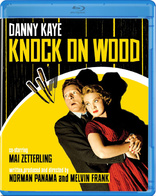
Price
List price: $24.95Amazon: $24.95
Third party: $20.27 (Save 19%)
Temporarily out of stock. We are working hard to be back in stock. Pla
Movie rating
7.3 | / 10 |
Blu-ray rating
| Users | 0.0 | |
| Reviewer | 3.0 | |
| Overall | 3.0 |
Overview
Knock on Wood (1954)
Discovering that a ventriloquist (Danny Kaye) is travelling to Zurich, a spy ring hides plans for a deadly secret weapon in his dummies' heads. When a second spy ring learns of the secret plans in his possession, they descend upon his hotelroom. The result is two dead agents, and Jerry is blamed. Hunted through London as the "Red-Headed Ripper", Jerry flees both police and spies. Eventually, the ringleader of the spies is apprehended by Jerry who is hailed a hero and is free to marry his beautiful lady psychiatrist Ilse Nordstrom (Mai Zetterling).
Starring: Danny Kaye, Mai Zetterling, Torin Thatcher, David Burns, Leon AskinDirector: Melvin Frank, Norman Panama
| Comedy | 100% |
Specifications
Video
Video codec: MPEG-4 AVC
Video resolution: 1080p
Aspect ratio: 1.78:1
Original aspect ratio: 1.75:1
Audio
English: DTS-HD Master Audio Mono
Subtitles
None
Discs
25GB Blu-ray Disc
Single disc (1 BD)
Playback
Region A (B, C untested)
Review
Rating summary
| Movie | 2.5 | |
| Video | 3.0 | |
| Audio | 3.0 | |
| Extras | 0.0 | |
| Overall | 3.0 |
Knock on Wood Blu-ray Movie Review
Who are you calling a dummy?
Reviewed by Jeffrey Kauffman August 8, 2013Did Paramount have a psychoanalyst on staff during the forties and fifties? The studio seemed intent on creating comedies built around patently neurotic characters who many times had to confront their neuroses, including overcoming fears or other mental “issues”, and even at times assuming other identities (how positively Freudian) to complete a task which would then magically “cure” them. Even a cursory glance at the persona Paramount star Bob Hope created in his film roles is an exemplar of this approach. Hope’s characters were often milquetoasts who would jump at the sight of their own shadows, but who overcame this dysfunction with an obviously intentionally comedic combination of avarice and, at times, lechery. Hope’s cowardice never quite arose to the panicked heights of, say, Universal’s Lou Costello in the many Abbott and Costello comedies where Lou would be so frightened at times he could barely speak, something which would of course then drive Bud Abbott to veritable distraction. One might think that Hope’s case was simply one of writers tailoring material to fit a certain comedian’s style, but a more studio-wide phenomenon perhaps comes into focus when one considers the case of Danny Kaye. Kaye did not have the longstanding relationship with Paramount that Hope did, and in fact by the time Kaye made Knock on Wood for the studio in 1951, he had already established himself in a series of films that bore the imprimaturs of such competitors as Samuel Goldwyn, Warner Brothers and 20th Century Fox. But it would be easy to see Hope taking over for Kaye in this somewhat labored by fitfully amusing entry, at least if one jettisoned the rapid patter songs around which Kaye had built much of his career. Kaye portrays a very Hope-like neurotic here, one whose fear of women leads him to sabotage burgeoning relationships, albeit through snarky comments voiced by the character’s ventriloquist dummy. Also as in a number of Hope entries, the Kaye character finds himself caught up in all sorts of intrigue, having to adopt various alter egos in order to ferret out what’s going on and clear his name.
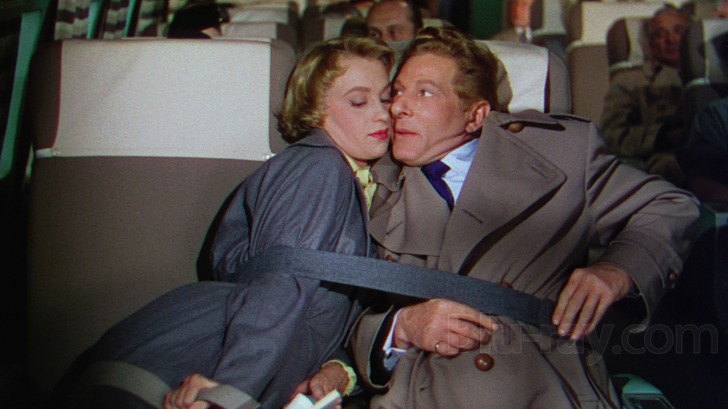
Neurosis isn’t just an implied subtext in Knock on Wood, it’s an out and out plot point, as successful ventriloquist Jerry Morgan (Danny Kaye) laments the fact that he can’t seem to control his own darker impulses whenever a relationship starts to get serious. After a brief prelude dealing with some top secret plans for a French super-weapon (something we obviously know is going to play into the overall plot), the film opens with one of Jerry’s dummies going off on Jerry’s latest girlfriend—on stage, no less. The woman is obviously less than pleased, and breaks off the love affair, leaving Jerry destitute. Jerry’s manager Marty Brown (David Burns) has arranged for Jerry to see a psychiatrist in Zurich, as he’s become more and more concerned that this tendency to sabotage relationships is indicative of some darker psychological strain weighing upon his client’s mind.
Jerry has had a fit of pique with his dummies and broken both of them, necessitating a trip to a dummy repair shop (there must be a lot of those, don’t you think?). Of course it turns out that the repairman is part of the cabal trying to steal the top secret plans, and when a thief who has purloined the plans shows up with Interpol hot on his trail, the two make a desperate decision to hide two sheets of paper—both of which are necessary to build the super-weapon— in the heads of each of the dummies. Things get even more complex when the thief is shot while relaying what’s happened to the plans to his contact. A slew of competing interests quickly finds out that the plans are with Jerry Morgan, though the fact that Jerry himself doesn’t know about the plans is not part of the information being imparted. Jerry has therefore become an unwitting accomplice in an international spy ring.
Marty and Jerry leave that same evening for a rendezvous in Zurich with a top flight psychiatrist. On the plane, Jerry has several unintentional run-ins with a beautiful young woman. He’s also approached by the head of one of the two spy rings competing for the plans, an English aristocrat named Godfrey Langston (Torin Thatcher). Langston thinks Jerry is a spy himself, and attempts to speak in code to the befuddled ventriloquist, attempting to divine how much money Jerry would want to sell the plans by using a metaphor for how many stars are outside of the airplane window. Jerry on the other hand thinks the conversation is completely literal, leading to massive confusion.
In Zurich, Jerry through a series of schtick laden mechanics, actually ends up in the beautiful young woman’s room overnight, waking up next to her then next morning (in twin beds, of course—after all, this was the fifties). Panicked, he leaves the room (in her high heeled bedroom slippers, no less) and heads off to his psychiatrist appointment. He’s consulted first by a male professional, who then states that Jerry’s case is so unusual he wants to bring in a colleague to aid in the analysis and, hopefully, Jerry’s ultimate cure. Guess who that turns out to be. Right—the beautiful young woman Jerry has already virtually assaulted through the film’s previous two sequences. She is Dr. Isle Nordstrom (Mai Zetterling), one of the most famous psychiatrists in the world.
Knock on Wood then does something most peculiar—Dr. Nordstrom injects Jerry with a hypnotic drug and she reverts him back to his childhood, at which point the film veers off into a really peculiar little sequence where young Jerry watches his feuding parents, who are in a vaudeville act, go on a bender and pretty violent fight. Nothing is shown explicitly on the screen, but it’s a patently bizarre moment of quasi-realism in an otherwise extremely fanciful outing.
Things trundle down a fairly predictable path, with Jerry and Ilse falling in love, while the two competing spy rings attempt to get the plans. Since there are two pieces of paper in two different dummies, it doesn’t take a rocket scientist (and/or a psychiatrist) to figure out what ultimately happens, but things get deadly when one of the spies is killed in Jerry’s hotel room and Jerry’s manager assumes that Jerry has finally flipped his lid and gone on a killing spree. This sets up the last half hour or so of the film, which is arguably its strongest element, where Jerry is on the run and ends up impersonating a bunch of different people, folks as disparate as a British car salesman and, later, a Russian ballet dancer.
Knock on Wood, despite its emphasis on the same kind of neuroses that figure in a glut of other Paramount comedies, is in fact obviously a vehicle tailor made for Kaye (Kaye’s own Dena Productions presented the film). There are a number of patter songs written by Kaye’s wife Sylvia Fine, and the film’s script, by Melvin Frank and Norman Panama, who also co-produced and co-directed) plays to Kaye’s strengths in mimicry, verbal acrobatics and physical comedy (all three of which show up in the later Frank-Panama collaboration with Kaye, The Court Jester, which hopefully will appear on Blu-ray soon). The film is still somewhat tiresome, with a predictable through line and too much emphasis on Kaye’s manic side, which can be overbearing in much the same way as another, later, Paramount star, Jerry Lewis.
The film does make good use of some nice second unit location work in London (though it’s easy to spot a body double for Kaye, always shot from the rear), and Zetterling makes a surprisingly nice romantic foil for the lead (she resembles Jane Powell quite strikingly in this film). There are some nicely humorous bits scattered throughout Knock on Wood, with the ballet sequence a real standout, but those are strung together with an otherwise fairly loose and lackluster screenplay that might have benefited from a little outside analysis itself.
Knock on Wood Blu-ray Movie, Video Quality 
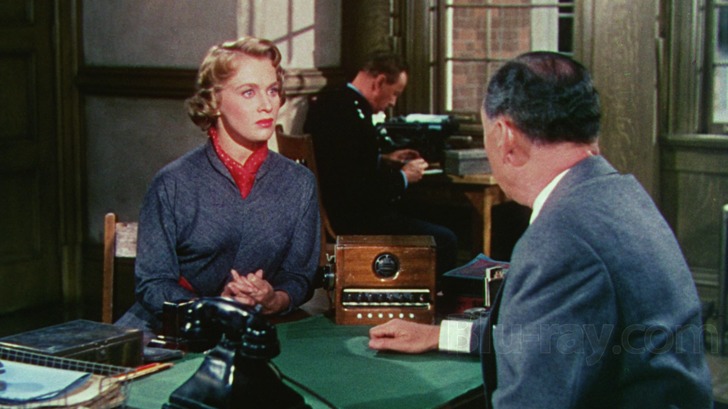
Knock on Wood is presented on Blu-ray courtesy of Olive Films with an AVC encoded 1080p transfer in 1.78:1. This film came at the tail end of the three strip Technicolor era, though it appears this was done with the then new Eastmancolor process. One way or the other, the elements here boast generally decent color, even if it appears this was sourced from dupes of some kind, as evidenced by an all around fuzziness (some of which gets to almost out of focus territory at times). There are several blemishes that crop up from time to time, including what appear to be flashing blotches of red, green or purple invading the image for very brief moments. There are some slight registration problems, with moderate issues that resemble fringing, especially in the last third or so of the film. At around 1:04:00 things get noticeably softer than the bulk of the film, something that continues for most of the rest of the outing. All of this said, though, generally things look nice, if not spectacular, with nicely saturated color (especially with regard to reds and blues) and above average fine detail. As with most Olive outings, no restoration or digital tweaking appears to have been done.
Knock on Wood Blu-ray Movie, Audio Quality 
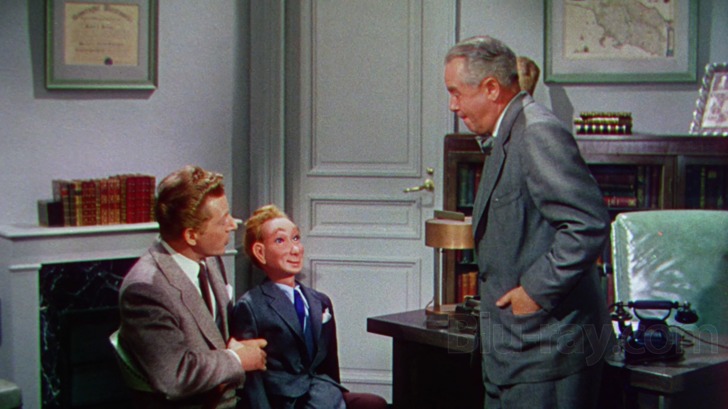
Knock on Wood features a lossless DTS-HD Master Audio Mono mix that has some very slight distortion in the midrange which slightly affects some of the music, including the songs Kaye sings. Otherwise, though, this is a clear presentation of a somewhat narrow sounding track. Dialogue is clean and easy to hear with very good fidelity. Dynamic range is negligible.
Knock on Wood Blu-ray Movie, Special Features and Extras 
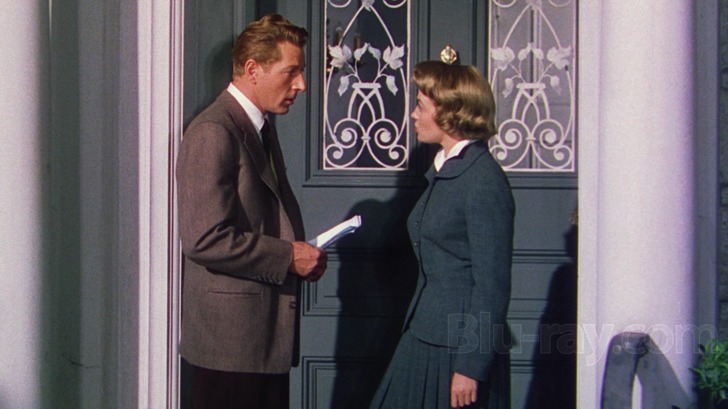
No supplements are included on this Blu-ray.
Knock on Wood Blu-ray Movie, Overall Score and Recommendation 
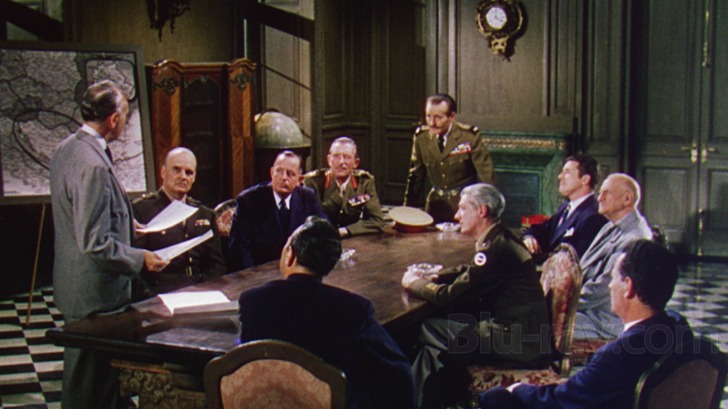
Knock on Wood has some cute bits, but overall it's a bit lethargic, even when it's filled to the brim with Kaye's mugging and tic-filled performance. Sylvia Fine contributes her typically brilliant patter material for Kaye, and a couple of the set pieces are amusingly done. This Blu-ray's image is generally decent, though it has some noticeable issues, as does the audio.
Similar titles
Similar titles you might also like

Outrageous Fortune
1987

The Decoy Bride
2011

My Favorite Blonde
1942

Cat Run
2011

Cluny Brown
1946

How to Be Single
2016

Genevieve
1953

Girls: The Complete First Season
2012

Good Neighbor Sam
1964

The Road to Hong Kong
Special Edition
1962

Cougar Town: The Complete Series
2009-2015

Stuck in Love
2013

Absolutely Fabulous: The Movie
2016

The Glass Bottom Boat
Warner Archive Collection
1966

Mr. Right
2015

Paris When It Sizzles
1964

Love Again
2023

Little Italy
2018

Divorce: The Complete First Season
2016

The Prince and the Showgirl
Warner Archive Collection
1957